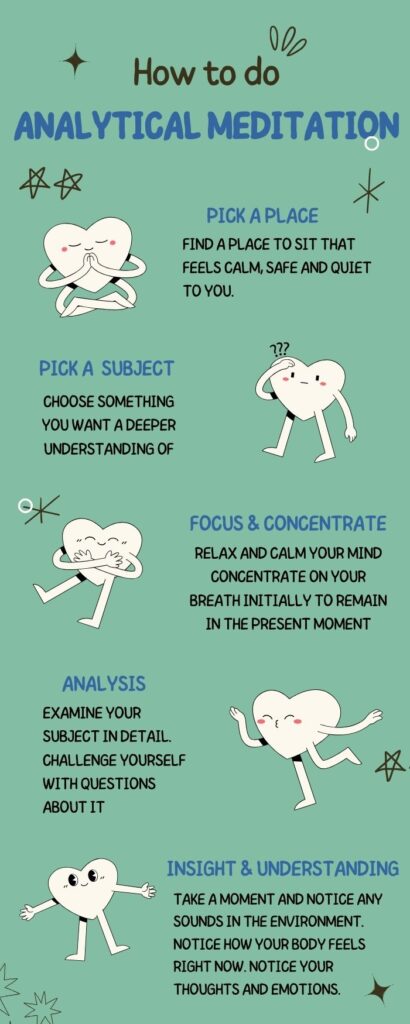If you want to know more about analytical meditation and how to do it, keep reading. This article will tell you what it is, how it works, and why this powerful practice should become part of your daily life!
Analytical meditation is a form of meditation that involves contemplation and analysis, which is different from the usual mindfulness meditation you are probably familiar with.
To undertake this meditative practice, all you need to do is:
- Find a quiet place
- Pick a meditation topic
- Calm yourself
- Focus and concentrate your mind on the subject at hand
- Analyse and contemplate the topic or idea, to develop a deeper understanding of yourself and the world around you.
Let’s find out how to master this meditation technique by taking a deeper look at
- What it is
- What the benefits are
- How to do it – a step-by-step guide
Table of Contents
Analytical meditation has its origins in Tibetan Buddhism. It is a technique that has been used for centuries to help individuals gain insight into the nature of the mind and develop a deeper understanding of Buddhist teachings. In Buddhist meditation techniques, analytical meditation is often used with mindfulness meditation.
The Dalai Lama sums analytical meditation up perfectly in the following quote:
“In this type of meditation one uses reasoning,” the Dalai Lama explains. “Reasoning can enhance positive states of mind and overcome the attitudes, thoughts and emotions that lead to suffering and dissatisfaction. In analytic meditation, one brings about inner change through systematic investigation and analysis. In this way we can properly use our human intelligence, our capacity for reason and analysis, to contribute to our happiness and satisfaction.”
Analytic Meditation Practice – A Deeper Understanding
An understanding of analytical meditation will help you to appreciate its benefits.
The purpose of this type of meditation is to examine the root causes of a particular problem and to develop a deeper understanding of an idea, belief, or concept.
You can use analytical meditation daily to help you develop a more realistic view of yourself and the environment around you and to help bring about inner change.
You can apply it to help navigate relationships, manage stress, or even take a deep dive into understanding life and death.
In analytical meditation, you reflect on an idea or concept to gain greater insight and understanding of the world around you.
In simple terms, you use this focused practice to break down an idea into its parts and then subject it to logical reasoning to conclude if that concept is to be accepted or rejected by you.
This type of meditation is used to examine the nature of the mind, thoughts, and emotions. It is a powerful tool for gaining mental clarity.
And the best bit? Most people find it simple to do and can remain focused for the entire experience!
What are the benefits of analytical meditation?
Analytical meditation is a powerful tool that can help individuals navigate the challenges of daily life. By engaging in this practice, you can develop a more realistic view of the world around you.
Some of the most significant benefits and positive changes analytical meditation can bring about are:
Stress Reduction
By examining the root causes of a particular problem, you will develop a greater sense of self-awareness and learn to manage your thoughts and emotions. With regular practice, you can bring about positive changes in your overall physical health.
You will feel the inner change in your body with daily practice, and you will develop foolproof strategies for dealing with your stress-inducing triggers.
Improved concentration
Regular practice of analytical meditation hones the skill of concentration. Focussing on a particular topic or single object for the duration of the practice helps to improve concentration.
Improved concentration will benefit you in alternative mindfulness meditations, where the onus may be to concentrate on your breath.
After regular practice, you may be aware that you have an improved ability to stay in the present moment and not worry about things you cannot control – bonus!
Positive changes in your state of mind and mental health
Analysing the root causes of a particular concept or problem helps alter or affirm your mental constructs and contributes to your spiritual growth.
Just by making analytical meditation part of your daily regimen you will achieve a more balanced and regular emotional state and begin to feel the inner change it is capable of inducing.
It provides an opportunity to develop a more realistic perspective on your problems.
So, what are you waiting for?
Let’s dive in and find out how you can reap these benefits with a step-by-step guide on how to do it.

A step-by-step guide on how to apply it in daily life
Pick a place, any place
First off, you can perform analytical meditation anywhere. From experience, I would suggest somewhere quiet that you can remain uninterrupted for the duration of the practice.
The living room of your house is just as suitable a venue as sitting at the kitchen table if afforded time for quiet contemplation.
Make sure you feel comfortable in the space.
How long should I meditate for?
Well, that is entirely up to you. There is no stopwatch to set. You can choose to sit in analytic meditation for however long you wish, but I find that my mind decides for me.
I often find that I naturally bring the practice to a close when my contemplation of a particular topic has stopped.
After I’ve tackled the subject from all angles and exhausted all the questions that arise in my mind during that sitting, I finish.
Try not to force it. You can re-visit the same subject the next time you practice if questions come to you later. Your ability, and length of time you can focus, will improve if you do this practice daily.
Consistency is important.
If you struggle to sit for long periods initially, concentrate on making it a regular daily practice instead, a go-to in your daily regimen.
With this approach, you will quickly be able to deepen your practice.
What topic should I choose to meditate on?
Your first question, right?
Well, there is not a particular topic that must be the subject of your analytical meditation practice.
It’s where the beauty lies with this type of meditative practice.
When choosing a topic, I advise you to pick something you want a deeper understanding of.
Choosing a subject that allows for this type of contemplative practice, one that you can approach with an analytical mind, that allows for deeper analysis, makes a good candidate.
It could be a personal or relationship problem, a philosophical question, or even a scientific concept. The important thing is that the topic is meaningful to you and that you are genuinely interested in exploring it.
Focus and Concentration
Ok, you’ve got some quiet time, picked your place, and decided to take a deep dive into a topic that has you wanting to know everything about it.
What now?
First, find a way to calm your mind and bring your attention to the present moment. Try not to let your mind wander away or be distracted.
I like to start calming my body and mind by using concentrative meditation to focus on my breath or a mantra – this works well for me.
When you’ve managed to come back into the now, the next step is to focus and concentrate your mind on the topic or idea, and you can begin the next phase.
Analysis and Contemplation
Once you have achieved a state of focus and concentration, you can begin the process of analysis and contemplation. This involves examining the topic or idea in detail and exploring its various aspects.
You can use logic and reasoning to examine the problem or concept’s root causes to develop a deeper understanding.
It is important to keep an open mind for the duration of the practice. Try to remain impartial.
Don’t allow your current belief systems to prevent you from being open to analysing the subject you have chosen. You want to ask yourself every question imaginable about it, even if you already think you know the answer to a particular question. Challenge your view.
Insight and Understanding
The final step in analytical meditation is gaining insight and understanding, enhancing your mental clarity.
This involves developing a new perspective on the topic or idea and gaining a deeper understanding. Pay close attention to any particular pattern arising when you think about a specific concept. What emotions stir in you? What are your triggers?
This can be done by reflecting on your analysis and contemplation and allowing your intuition and intellect to work together to gain new insights.
I recommend you keep a journal of every practice, bullet points are enough.
I note my practice topic, how I feel emotionally at the start of practice and my mindset.
I document my thoughts and beliefs about the subject before I start analysis of it.
I write what questions I ask myself, what emotions stir in me when I ask a specific question, and why I think I responded this way. Is this a positive or negative response, and did I change my understanding of the subject?
This reflective process is also a great way to decide if you have explored a subject thoroughly and are ready to move on to another.
If you make this a regular practice, you will start to benefit from improvements in mental clarity. Analytical meditation can also help to overcome negative characteristics and develop positive qualities such as compassion, wisdom, and patience.
These are just some of the various ways that this particular form of Buddhist meditation can change you as a human being, opening you up to amazing life experiences.

Finally
Analytical meditation is an amazing tool for gaining insight and understanding into complex problems and ideas.
Unlike other forms of meditation that focus on relaxation and clearing the mind, analytical meditation involves actively engaging with a particular concept or idea. For me, this is what makes it so easy to do.
Allowing your mind to engage is at the core of this practice.
In my opinion, analytical meditation is a powerful practice to integrate into your daily life to gain emotional understanding, improve your cognitive behaviour, and develop an enhanced perspective of the world around you.
These benefits can lead to greater self-awareness, improved relationships, and a greater sense of inner peace.
Who wouldn’t want that?
Today is as good a time as tomorrow to get started.
Frequently Asked Questions
How can analytical meditation help me overcome negative emotions?
Analytical meditation can help to overcome negative emotions by examining the root causes of those emotions.
By analysing the nature of the emotion and its underlying causes, we can gain a deeper understanding of the emotion and learn how to respond to it more constructively.
This leads to a reduction in negative emotions and an increase in positive ones, such as happiness and contentment.
What are some common obstacles to practising analytical meditation and how can they be overcome?
Common obstacles to practising analytical meditation include distractions, lack of motivation, and difficulty focusing the mind.
Overcome these obstacles by setting aside a specific time and place for meditation, reducing distractions and interruptions, and using techniques such as visualisation or breath awareness to help focus the mind.
What are some effective techniques for guiding yourself in analytical meditation?
Techniques for guiding yourself in analytical meditation include using a specific topic or question to focus the mind.
Break down the topic or question into parts, and use reasoning and analysis to gain insight into the topic or question.
Visualisation and breath awareness can also help guide you in analytical meditation.
How can analytical meditation be integrated into a daily meditation practice?
Analytical meditation can be integrated into a daily meditation practice by setting aside a specific time and place for meditation.
It can also be helpful to start with shorter periods of meditation and gradually increase the length of the meditation over time.

